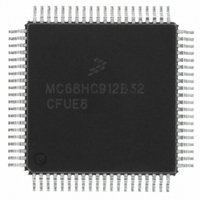MCHC912B32CFUE8 Freescale Semiconductor, MCHC912B32CFUE8 Datasheet - Page 217

MCHC912B32CFUE8
Manufacturer Part Number
MCHC912B32CFUE8
Description
IC MCU 32K FLASH 8MHZ 80-QFP
Manufacturer
Freescale Semiconductor
Series
HC12r
Datasheet
1.MCHC912B32CFUE8.pdf
(334 pages)
Specifications of MCHC912B32CFUE8
Core Processor
CPU12
Core Size
16-Bit
Speed
8MHz
Connectivity
SCI, SPI
Peripherals
POR, PWM, WDT
Number Of I /o
63
Program Memory Size
32KB (32K x 8)
Program Memory Type
FLASH
Eeprom Size
768 x 8
Ram Size
1K x 8
Voltage - Supply (vcc/vdd)
4.5 V ~ 5.5 V
Data Converters
A/D 8x10b
Oscillator Type
External
Operating Temperature
-40°C ~ 85°C
Package / Case
80-QFP
Cpu Family
HC12
Device Core Size
16b
Frequency (max)
8MHz
Interface Type
SCI/SPI
Total Internal Ram Size
1KB
# I/os (max)
63
Operating Supply Voltage (typ)
5V
Operating Supply Voltage (max)
5.5V
Operating Supply Voltage (min)
4.5V
On-chip Adc
8-chx10-bit
Instruction Set Architecture
CISC
Operating Temp Range
-40C to 85C
Operating Temperature Classification
Industrial
Mounting
Surface Mount
Pin Count
80
Package Type
PQFP
Package
80PQFP
Family Name
HC12
Maximum Speed
8 MHz
Operating Supply Voltage
5 V
Data Bus Width
16 Bit
Number Of Programmable I/os
63
Processor Series
HC912B
Core
HC12
Data Ram Size
1 KB
Maximum Clock Frequency
8 MHz
Maximum Operating Temperature
+ 85 C
Mounting Style
SMD/SMT
3rd Party Development Tools
EWHCS12
Development Tools By Supplier
M68EVB912B32E
Minimum Operating Temperature
- 40 C
Lead Free Status / RoHS Status
Lead free / RoHS Compliant
Available stocks
Company
Part Number
Manufacturer
Quantity
Price
Company:
Part Number:
MCHC912B32CFUE8
Manufacturer:
Freescale Semiconductor
Quantity:
10 000
- Current page: 217 of 334
- Download datasheet (2Mb)
15.5.3 BDLC Stop and CPU Stop Mode
This power-conserving mode is entered automatically from run mode when the WCM bit in the BCR1
register is set followed by a CPU STOP instruction. This is the lowest-power mode that the BDLC can
enter.
In this mode:
The first passive-to-active transition on the J1850 network generates a non-maskable ($20) CPU interrupt
request by the BDLC, allowing the CPU clocks to restart and the BDLC internal clocks to restart.
Therefore, the new message which wakes up the BDLC from the BDLC stop mode and the CPU from the
CPU wait mode are not received correctly. This is due primarily to the time required for the MCU’s
oscillator to stabilize before the clocks can be applied internally to the other MCU modules, including the
BDLC.
15.6 Loopback Modes
Two loopback modes are used to determine the source of bus faults.
15.6.0.1 Digital Loopback Mode
When a bus fault has been detected, the digital loopback mode is used to determine if the fault condition
is caused by failure in the node’s internal circuits or elsewhere in the network, including the node’s analog
physical interface. In this mode, the transmit digital output pin (BDTxD) and the receive digital input pin
(BDRxD) of the digital interface are disconnected from the analog physical interface and tied together to
allow the digital portion of the BDLC to transmit and receive its own messages without driving the J1850
bus.
15.6.0.2 Analog Loopback Mode
Analog loopback mode is used to determine if a bus fault has been caused by a failure in the node’s
off-chip analog transceiver or elsewhere in the network. The BDLC analog loopback mode does not
modify the digital transmit or receive functions of the BDLC. It does, however, ensure that once analog
loopback mode is exited, the BDLC waits for an idle bus condition before participation in network
communication resumes. If the off-chip analog transceiver has a loopback mode, it usually causes the
input to the output drive stage to be looped back into the receiver, allowing the node to receive messages
it has transmitted without driving the J1850 bus. In this mode, the output to the J1850 bus typically is high
impedance. This allows the communication path through the analog transceiver to be tested without
interfering with network activity. Using the BDLC analog loopback mode in conjunction with the analog
transceiver’s loopback mode ensures that, once the off-chip analog transceiver has exited loopback
mode, the BDLC does not begin communicating before a known condition exists on the J1850 bus.
Freescale Semiconductor
•
•
•
The BDLC internal clocks are stopped.
The CPU internal clocks are stopped.
The BDLC awaits J1850 network activity.
Ensure that all transmissions are complete or aborted prior to putting the
BDLC into stop mode (WCM = 1 in BCR1).
M68HC12B Family Data Sheet, Rev. 9.1
NOTE
Loopback Modes
217
Related parts for MCHC912B32CFUE8
Image
Part Number
Description
Manufacturer
Datasheet
Request
R
Part Number:
Description:
Manufacturer:
Freescale Semiconductor, Inc
Datasheet:
Part Number:
Description:
Manufacturer:
Freescale Semiconductor, Inc
Datasheet:
Part Number:
Description:
Manufacturer:
Freescale Semiconductor, Inc
Datasheet:
Part Number:
Description:
Manufacturer:
Freescale Semiconductor, Inc
Datasheet:
Part Number:
Description:
Manufacturer:
Freescale Semiconductor, Inc
Datasheet:
Part Number:
Description:
Manufacturer:
Freescale Semiconductor, Inc
Datasheet:
Part Number:
Description:
Manufacturer:
Freescale Semiconductor, Inc
Datasheet:
Part Number:
Description:
Manufacturer:
Freescale Semiconductor, Inc
Datasheet:
Part Number:
Description:
Manufacturer:
Freescale Semiconductor, Inc
Datasheet:
Part Number:
Description:
Manufacturer:
Freescale Semiconductor, Inc
Datasheet:
Part Number:
Description:
Manufacturer:
Freescale Semiconductor, Inc
Datasheet:
Part Number:
Description:
Manufacturer:
Freescale Semiconductor, Inc
Datasheet:
Part Number:
Description:
Manufacturer:
Freescale Semiconductor, Inc
Datasheet:
Part Number:
Description:
Manufacturer:
Freescale Semiconductor, Inc
Datasheet:
Part Number:
Description:
Manufacturer:
Freescale Semiconductor, Inc
Datasheet:











